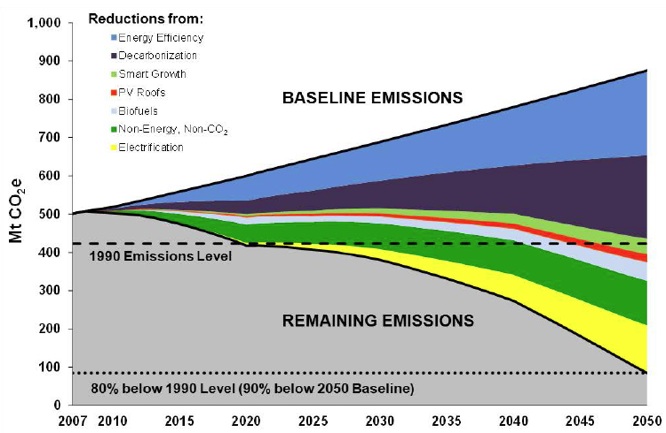
Image Credit: Lawrence Berkeley National Laboratory
If California is going to stay on schedule to meet carbon emissions goals mandated in 2006 by Governor Arnold Schwarzenegger, energy-efficient homes will become much more common and electric power will, by 2050, become the principal energy source for the state’s residents and businesses. Those are some of the conclusions found in a study conducted by scientists from the U.S. Department of Energy’s Lawrence Berkeley National Laboratory and San Francisco-based consulting firm Energy and Environmental Economics.
Factoring in population and economic changes, the scientists created a prescriptive model for ways that the residential, commercial, industrial, agricultural, and transportation sectors, as well as the petroleum-industry and fuel and electricity suppliers, could collectively drive greenhouse gas emissions 80% below 1990 levels by 2050. The model focuses on emission levels beginning in 2010 and their likely rate of reduction, assuming the current pace of technological innovation continues, 40 years out.
The success of the model is contingent on addressing carbon reduction in four basic areas and in a certain order: first, energy efficiency; then decarbonization of electricity generation; then reduction of emissions from landfill and agricultural activities; and then electrification of transportation and other services.
If the progression is followed and the reduction targets are met, the scientists say, California’s carbon dioxide emissions would be reduced from 875 million metric tons in 2050 – the “baseline” level of emissions expected if no measures are taken – to 85 million metric tons.
Building on Title 24
California already has Title 24, regarded as the most stringent state code regulating energy efficiency standards for residential and commercial buildings. And in fact, improvements in the performance of buildings – via better-insulated and more-airtight envelopes, and more-efficient lighting and appliances – account for the “largest share” of greenhouse gas reduction among the model’s energy efficiency targets.
Overall, meeting the energy efficiency goals prescribed by the model would cover 28% of the emissions reductions required over the next 38 years. The challenge here is that even though the scientists regard energy efficiency as “low-hanging fruit,” it still has to improve by at least 1.3% annually to yield the desired overall result. That level of improvement was exceeded during the 2000-2001 electricity crisis, a Lawrence Berkeley Lab article about the study notes, but not sustained before or since then.
Decarbonizing electricity generation, and beyond
The study’s authors see the use of renewable energy, nuclear power, and fossil fuel generation mitigated by carbon-capture and storage technologies as the principal means of decarbonizing electricity generation. The challenges accompanying these options – which, the scientists say, are solvable – are that they’re currently more expensive than conventional power generation and still have to overcome technical limitations. In any case, all three will likely have to be deployed in concert, even if the performance of renewable-energy sources and related storage technologies improve significantly and the use of renewables increases enough to cover most of the state’s electricity needs.
According to the model, an estimated 15% of emission reductions could come from reducing landfill and agricultural activities, and another 14% could come from a variety of other practices, such as smart urban planning, installation of rooftop photovoltaic arrays, and the use of biofuels for trucking and airline services.
The final challenge will be to electrify cars, heating devices, and industrial processes that currently rely on fossil fuels, which, by 2050, would push the use of electricity as a primary energy source from 15% to 55% of applications. The electrification of vehicles is expected to produce the biggest share of reductions, by far, in this category. And that, the scientists say, would bring overall carbon emissions down enough to meet the reduction goal for 2050.
Weekly Newsletter
Get building science and energy efficiency advice, plus special offers, in your inbox.














0 Comments
Log in or create an account to post a comment.
Sign up Log in